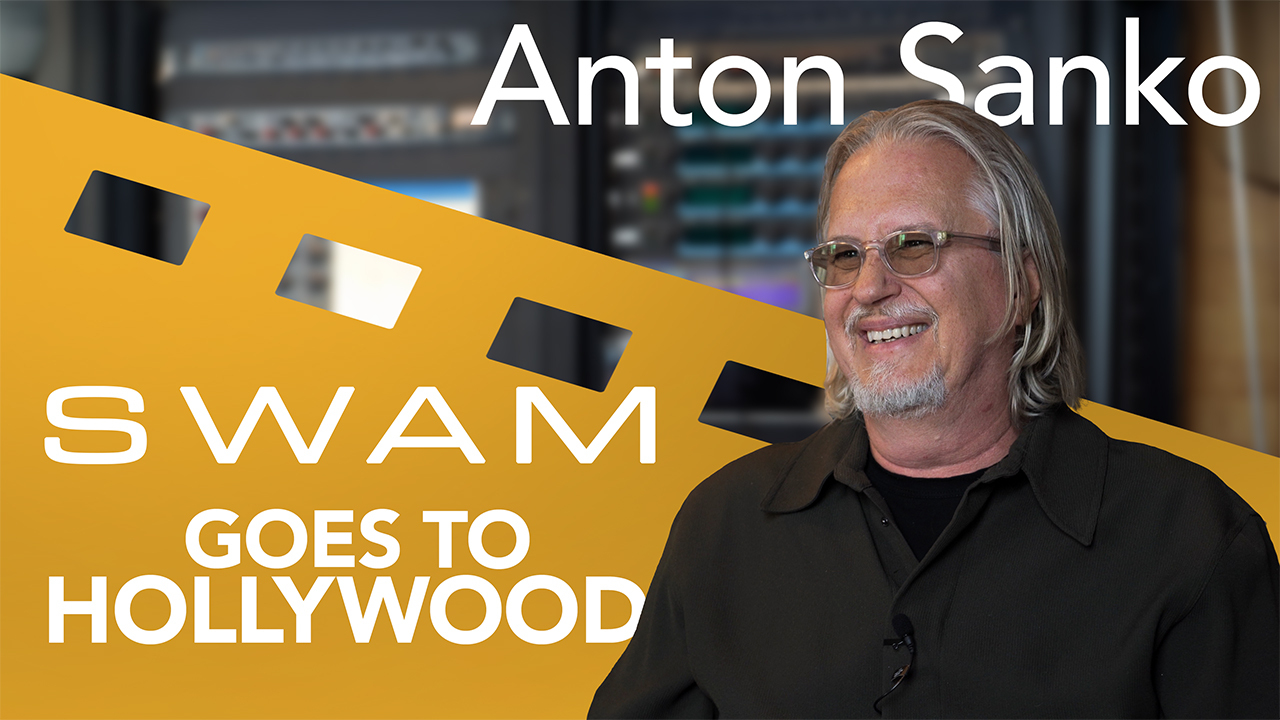In the debut episode of our SWAM Goes to Hollywood series, we had the privilege of interviewing Anton Sanko, the award-winning composer and producer known for his work on iconic films like The Possession and Rabbit Hole, as well as the Emmy-winning HBO series Big Love. Anton Sanko has gained acclaim for his unique ability to blend classical orchestration with cutting-edge music technology, creating soundscapes that captivate audiences.
Anton welcomed us into his eclectic Los Angeles studio, an inspiring space filled with an impressive mix of instruments—from rare antiques to modern synthesizers. Throughout our interview, Anton opened up about his journey into the world of film scoring, his distinctive creative process, and his approach to incorporating SWAM instruments for realistic, expressive orchestration. This conversation is packed with valuable insights into Anton’s career, his notable experiences, and his views on how SWAM is revolutionizing the art of film composition.
For anyone passionate about film music, orchestral composition, or audio technology, this interview with Anton Sanko offers a rare behind-the-scenes look at the future of music in cinema.
Early Inspirations: From John Barry’s Bond Soundtracks to Modern Film Scoring
When asked about the origins of his passion for orchestral music, Anton Sanko recalls his childhood fascination with John Barry’s James Bond soundtracks. “John Barry changed my life,” Anton shared, crediting Barry’s iconic scores as his gateway into the world of orchestration. This powerful influence laid the foundation for Anton’s musical journey, which soon expanded to embrace the complex compositions of artists like György Ligeti and Karlheinz Stockhausen.
A Career-Defining Encounter with Jonathan Demme: Anton Sanko’s Path into Film Scoring
Anton Sanko’s journey into film scoring took a transformative turn through a chance encounter with Jonathan Demme, the Oscar-winning director of Silence of the Lambs. Their friendship evolved over the years, ultimately leading Demme to invite Anton to score a documentary. This project marked Anton’s first real experience in film scoring. “It took me a year, and I got paid $500. I didn’t know what I was doing,” Anton recalls with a laugh. But this humble beginning set him on the path he had always dreamed of.
Lacking formal training or access to today’s comprehensive scoring programs, Anton had to “learn by doing.” Reflecting on those early years, he notes, “Back then, there weren’t any scoring programs—you just had to figure it out as you went along.” His story is a testament to perseverance, talent and passion, showcasing how a single opportunity can define a career in film composition.
Crafting the Perfect Mockup: Anton Sanko’s Essential Process in Film Scoring
In film scoring, Anton Sanko emphasizes the critical importance of creating highly detailed mockups to effectively communicate his musical vision. Rather than relying solely on traditional scores, Anton uses his mockup to present a clear, realistic preview of the final music to directors and producers, helping align the creative team’s expectations from the outset.
To create orchestral mockups, Anton’s process involves assembling a vast number of tracks within his DAW (Digital Audio Workstation). Each track represents a unique articulation or sample for a particular instrument, requiring an enormous number of individual layers just to simulate a single orchestral section like strings. This detailed mockup is what enables his orchestrator to take the MIDI files and accurately translate them into sheet music for studio musicians, bridging the gap between digital composition and live performance. By perfecting his mockup, Anton achieves a sound that is remarkably close to the final recorded version—a valuable preview for production teams.
However, crafting these mockups comes with its own set of challenges. “It’s a nightmare,” Anton admits, referring not to the computing power or memory requirements (although they are significant) but rather to the vast complexity of managing so many tracks. Each articulation—pizzicato, staccato, legato, and more—requires a separate track, turning the DAW session into a massive puzzle. This meticulous assembly, or “Frankenstein” of samples, is necessary to create a realistic sound that accurately conveys the final effect.
“It’s a ton of stuff, and you need all this loaded in the DAW just to create a cohesive sound,” Anton explains, underscoring the immense technical demands of modern film scoring.
In Anton’s workflow, the mockup is the cornerstone of his scoring process, allowing him to deliver a near-final soundscape that guides both production teams and orchestrators, ensuring his creative vision is seamlessly realized in the recording studio.
Anton Sanko’s Experience with SWAM Solo Instruments in Composition
In our interview, Anton Sanko shared his insights on using SWAM solo instruments and how they enhance the digital composition experience. As a long-time user, Anton appreciates the physical modeling technology behind SWAM, which offers a significant advantage over traditional sample-based libraries. “When you’re playing sample-based libraries, there’s always a lag,” he explains. “But with SWAM, if you play fast, it plays fast. You play slow, it plays legato. It does what you want it to do.”
Anton praises SWAM for its responsiveness to the musician’s touch, calling it “liberating.” Unlike conventional libraries that often require key switches to manage articulations, SWAM instruments adapt directly to real-time input, making the composition process far more intuitive and expressive.
“I think all the SWAM instruments are liberating because you play what you hear in your head,” Anton says. “You don’t have to keep switching around to find the right key switch. It’s super responsive.”
With SWAM’s technology, Anton is able to compose with a fluidity and precision similar to a live performance—a transformative quality that makes SWAM a game-changer in digital orchestration. This familiarity with SWAM’s solo instruments set the stage for our later demonstration of SWAM String Sections, revealing an innovative solution to managing complex orchestral templates.
The Power of Realism: Exploring SWAM’s String Sections in a Live Demonstration
In a hands-on demonstration of the SWAM String Sections, Claudio Passavanti aka Doctor Mix performed a live piece for Anton Sanko, showcasing how SWAM’s advanced features allow for seamless orchestration by layering each instrument in real-time. The demonstration highlighted SWAM’s remarkable spatial realism and dynamic control, as Claudio adjusted bow pressure, bow position, and expression directly during the performance—a level of responsiveness that left Anton thoroughly impressed.
“You just change that in real-time—that’s incredible!” Anton remarked, visibly amazed by SWAM’s intuitive manipulation of dynamics and expression.
The realistic quality of SWAM Strings, particularly its divisi functionality and positional adjustments within the orchestral space (thanks to Ambiente Room Simulator), stood out to Anton. He appreciated how these features create authentic, organic sound variations, free from the phasing issues that often occur in traditional sample-based libraries. SWAM’s approach to orchestration offered Anton a new perspective on achieving realism in digital music composition.
The SWAM Advantage: “It Feels Like Playing a Real Instrument”
After the demonstration, Anton Sanko shared his enthusiastic thoughts on the standout benefits of SWAM instruments. For Anton, the defining feature of SWAM is its ability to respond naturally to a musician’s touch, offering an impressively authentic playing experience. “It plays like a real instrument,” he noted, describing the experience as “liberating, especially when you don’t have to deal with key switching. SWAM is much more expressive than anything else I’ve tried.”
Anton is particularly excited to integrate SWAM Strings into future projects, captivated by their minimal memory requirements and exceptionally realistic sound quality.
“They sound beautiful, and they’re so responsive. It’s a must-have,” he added with enthusiasm.
In an endorsement, Anton also highlighted how essential SWAM has become in his daily work: “I love all the SWAM stuff and use it daily – I couldn’t live without the flutes and all the brass.”
For composers looking for realism and expressive control in digital music, SWAM offers an unparalleled tool to elevate digital composition.
Watch the Full Interview with Anton Sanko!
Our exclusive interview with Anton Sanko is a must-watch for enthusiasts of film scoring, music composition, and audio technology. Discover Anton’s journey into the world of film, his creative process, and his hands-on experience with SWAM instruments in this behind-the-scenes look at a master composer at work.
Don’t miss this chance to watch the full episode of SWAM Goes to Hollywood and witness how SWAM’s groundbreaking technology is transforming the way composers like Anton Sanko approach music. Gain invaluable insights into the future of orchestral composition and film scoring—watch now!

